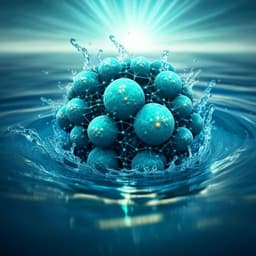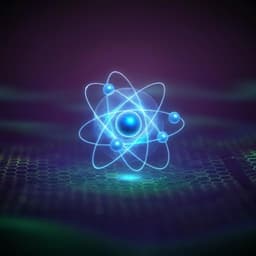
Chemistry
Atomically dispersed asymmetric cobalt electrocatalyst for efficient hydrogen peroxide production in neutral media
L. Liu, L. Kang, et al.
Discover the groundbreaking research by Longxiang Liu and colleagues, exploring the efficient electrochemical production of hydrogen peroxide using innovative M-N-C electrocatalysts. This study uncovers exceptional performance in neutral media, revealing the potential of asymmetric configurations for enhanced activity and selectivity.
~3 min • Beginner • English
Introduction
Hydrogen peroxide demand is growing rapidly, yet current industrial production relies on the energy-intensive anthraquinone process that generates waste and produces high concentrations not always needed. Electrochemical H2O2 production via the 2e− ORR offers a decentralized, lower-energy route, especially valuable for low-concentration applications and neutral media. M–N–C catalysts with atomically dispersed 3d transition metals on N-doped carbon are promising, but many active species are buried in the bulk, limiting utilization and increasing cost. Additionally, rising metal prices and supply risks necessitate improved utilization strategies. A central challenge is accurately identifying the active site structure due to ambiguous electronic configurations and disorder introduced during high-temperature annealing; EXAFS fitting often cannot distinguish M–C/N/O coordination because of similar bond lengths and atomic numbers, potentially leading to misleading assignments (e.g., the commonly proposed symmetric square-planar M–N4 model). The study aims to design surface-anchored, ultra-low-loading M–N–C catalysts to maximize exposed active sites and to elucidate the structure–performance relationship for EHPP in neutral media, specifically testing whether asymmetric Co–C/N/O configurations outperform symmetric Co–N4 motifs.
Literature Review
Prior work widely adopts square-planar M–N4 models for M–N–C catalysts based on XAFS (XANES and FT-EXAFS) analysis, but the technique has limitations distinguishing among M–C, M–N, and M–O coordination due to similar scattering paths and bond lengths, potentially resulting in ambiguous or misleading structural assignments. M–N–C catalysts have delivered promising EHPP activity, and cobalt–N–C motifs have been highlighted for selective 2e− ORR; however, most studies focus on acidic or alkaline media, with fewer addressing neutral conditions relevant to many applications. Reports also indicate that modifying first and second coordination spheres (e.g., O-coordination or defects) can tune selectivity. The literature underscores challenges: (i) buried active sites in bulk carbon, reducing utilization; (ii) uncertainty in exact coordination environments from ensemble-averaged EXAFS; and (iii) potential discrepancies in kinetic analyses across studies due to different loadings and structures. These gaps motivate strategies to anchor metal sites at the carbon surface and to explore asymmetric coordination environments that may optimize OOH* binding for selective H2O2 production in neutral electrolytes.
Methodology
- Catalyst synthesis: Surface engineering was employed to anchor 3d transition metals (Mn, Fe, Co, Ni, Cu) with ultralow loadings (<0.1 wt%) onto oxidized carbon black (OCB), followed by NH3 annealing (850 °C, 1 h) to form M–N–C on carbon black (MNCB). Post-anneal acid leaching (4 M HCl) removed residual metal species. A metal-free N-doped carbon black (NCB) control was prepared identically without metal precursor. Metal loadings were quantified by MP-AES (Mn 0.04 wt%, Fe 0.05 wt%, Co 0.05 wt%, Ni 0.08 wt%, Cu 0.06 wt%). A Co-porphyrin (CoPr) was also deposited on CB to model symmetric Co–N4 for comparison.
- Structural characterization: Aberration-corrected STEM (ABF- and HAADF-STEM) confirmed atomically dispersed metal sites on the carbon surface without nanoparticles. Soft X-ray NEXAFS (Co L-edge, N K-edge, O K-edge) in TEY mode probed surface electronic states; O K-edge features indicated partial removal of oxygen groups after annealing with residual O-functionalities. Co L3-edge of CoNCB lacked the characteristic square-planar Co–N4 features observed for CoPr, suggesting absence of symmetric D4h coordination. Hard X-ray Co K-edge XAS (XANES, FT-EXAFS, WT-EXAFS) probed bulk coordination: CoNCB exhibited an increased pre-edge and loss of the Co–N4 shoulder feature, consistent with asymmetric/distorted coordination; however, due to similar scattering of C/N/O and ensemble averaging, precise coordination numbers and identities could not be uniquely determined.
- Electrochemical testing (RRDE): ORR activity/selectivity assessed in O2-saturated 0.1 M phosphate buffer (pH 7) using a glassy carbon disk/Pt ring RRDE (N ≈ 0.37). CV preconditioning was followed by LSV at 10 mV s−1, 1600 rpm; ring held at 1.2 V vs RHE. H2O2 selectivity calculated from disk/ring currents. Tafel slopes for H2O2 formation were extracted using Koutecky–Levich analysis with a limiting current of 2.9 mA cm−2 for the 2e− ORR.
- Flow cell evaluation: Gas diffusion electrodes (Sigracet 29 BC) loaded with CoNCB (0.2 mg cm−2) operated in a two-compartment flow cell (NR-212 membrane) with 1 M PBS at 20 mA cm−2. H2O2 quantified by Ce(SO4)2 titration (UV–vis at 319 nm) to determine production rate and Faradaic efficiency.
- Computational studies: DFT (VASP, spin-polarized PBE+D3, PAW, 400 eV cutoff, ~15 Å vacuum) modeled eight C2v-like asymmetric Co–C/N/O configurations (various Co–C/N/O coordination paths) and a symmetric CoN4 reference. Gibbs free energies for 2e− ORR steps were evaluated via the CHE model. OOH* adsorption free energy (Gad(OOH*)) served as the activity/selectivity descriptor; limiting potentials (UL) were mapped onto a volcano plot. PDOS and d-band centers were analyzed; off-center distances of Co relative to the graphene plane quantified geometric asymmetry. XANES spectra were simulated with FDMNES for model validation.
Key Findings
- CoNCB exhibits superior EHPP performance in neutral media compared to Mn-, Fe-, Ni-, and Cu-based analogues and metal-free NCB: onset potential (at 0.1 mA cm−2) 0.76 V (CoNCB) > FeNCB (0.61 V) > MnNCB (0.55 V) > CuNCB (0.54 V) > NiNCB = NCB (0.50 V).
- H2O2 selectivity of CoNCB exceeds 95% across 0.45–0.75 V vs RHE; Fe/Mn/Cu species deteriorate selectivity, Ni has negligible effect versus NCB.
- Mass activity normalized to cobalt: 6.1 × 10^5 A gCo−1 at 0.5 V vs RHE; turnover frequency: 186 s−1 at 0.5 V, outperforming reported Co–N–C catalysts by large margins.
- Kinetics: Tafel slope for H2O2 formation 62 mV dec−1 (CoNCB), versus MnNCB 98, NCB=NiNCB 103, CuNCB 104 mV dec−1. The slope suggests the first electron transfer to form OOH* is not rate-determining.
- RRDE ring current maxima: CoNCB 2.61 mA cm−2 at 0.49 V; NCB 2.32 mA cm−2 at 0.19 V; MnNCB 1.62 mA cm−2 at 0.25 V; CuNCB 1.71 mA cm−2 at 0.22 V; FeNCB 0.97 mA cm−2 at 0.09 V.
- Structural spectroscopy: Co L-edge and Co K-edge XAS of CoNCB lack the square-planar Co–N4 signatures and show increased pre-edge intensity, indicating asymmetric/distorted Co–C/N/O environments rather than symmetric D4h Co–N4.
- Stability: After 5000 ADT cycles, potentials to reach 0.1 and 1 mA cm−2 shift by only 20 mV and 39 mV, with high selectivity maintained.
- Flow cell performance (1 M PBS, 20 mA cm−2, 5 h): average H2O2 production rate 4.72 mol gcatalyst−1 h−1 cm−2 with Faradaic efficiency >60%; stable operation with slight LSV decrease attributed to electrolyte leaching.
- Benchmarking versus Co–N4: While Co–N4 improves onset potential compared to NCB, its H2O2 selectivity is much lower than CoNCB in neutral media; CoNCB’s selectivity advantage persists in acidic (pH 1) and alkaline (pH 13) conditions.
- DFT: Asymmetric Co–C/N/O configurations present stronger OOH* binding (most on the left side of the volcano, reduction of OOH* to H2O2 as RDS) and reduced H2O2 dissociation, supporting higher selectivity. A positive correlation exists between the Co off-center distance (geometric asymmetry) and Gad(OOH*). PDOS shows asymmetric models have fewer occupied states near the Fermi level and more negative d-band centers than CoN4, consistent with tuned intermediate adsorption. Simulated XANES for models reproduces key experimental features.
Discussion
The study demonstrates that engineering asymmetric Co–C/N/O single-atom sites on the surface of N-doped carbon black markedly improves EHPP in neutral media relative to symmetric Co–N4 motifs. Spectroscopy (NEXAFS/XANES/EXAFS) indicates loss of square-planar symmetry and the presence of distorted coordination environments, consistent with surface anchoring on a distorted carbon matrix. Electrochemical measurements show higher onset potentials, significantly enhanced H2O2 selectivity (>95% over a wide potential window), superior mass activity and TOF, and robust stability. DFT rationalizes these observations: asymmetric coordination increases geometric distortion (off-center Co), which correlates positively with OOH* adsorption free energy, situating most asymmetric models on the optimal side of the activity volcano for 2e− ORR while suppressing H2O2 dissociation. Electronic structure analysis (PDOS, d-band) supports moderated adsorption strengths favoring selective H2O2 formation. Collectively, the results address the core hypothesis that asymmetry in Co coordination is beneficial for neutral-media EHPP and provide a structure–performance framework for designing high-performing single-atom catalysts.
Conclusion
This work introduces a surface engineering strategy to create ultralow-loading, atomically dispersed Co–C/N/O sites on N-doped carbon black that deliver outstanding EHPP performance in neutral electrolyte: onset potential of 0.76 V (at 0.1 mA cm−2), >95% H2O2 selectivity from 0.45–0.75 V, mass activity 6.1 × 10^5 A gCo−1, TOF 186 s−1, and a practical flow-cell production rate of 4.72 mol gcatalyst−1 h−1 cm−2 with >60% Faradaic efficiency. Spectroscopic analyses confirm asymmetric Co coordination distinct from symmetric Co–N4, and DFT establishes a quantitative link between geometric asymmetry (off-center Co) and OOH* adsorption that underpins activity and selectivity. The findings provide methodological guidance for electronic structure evaluation of M–N–C catalysts and emphasize the advantages of asymmetric coordination in neutral media. Future research should pursue operando spectroscopies to further resolve coordination environments, refine models that include additional factors (e.g., adjacent carbon layers or second-sphere effects), optimize catalyst/support architectures to minimize electrolyte leaching in devices, and extend the asymmetric design principle across other metals and electrolytes.
Limitations
- Structural determination limits: Due to similar scattering properties of C, N, and O and ensemble averaging in EXAFS, precise coordination numbers and identities around Co could not be uniquely resolved; multiple Co–C/N/O configurations fit the data comparably. The ultra-low Co loading reduced signal-to-noise, complicating L-edge assignments; N K-edge data were affected by contamination.
- Methodological constraints: FT-EXAFS fitting suffers from systematic uncertainties in coordination number determination; thus, exact active-site structures remain a distribution rather than a single well-defined model.
- Device testing: In flow-cell operation, slight electrolyte leaching was observed, lowering Faradaic efficiency over time and modestly degrading LSV performance.
- Comparative kinetics: Reported Tafel slopes for different M–N–C materials may deviate from literature values due to differences in metal loadings and catalyst structures, limiting direct cross-study comparisons.
Related Publications
Explore these studies to deepen your understanding of the subject.







